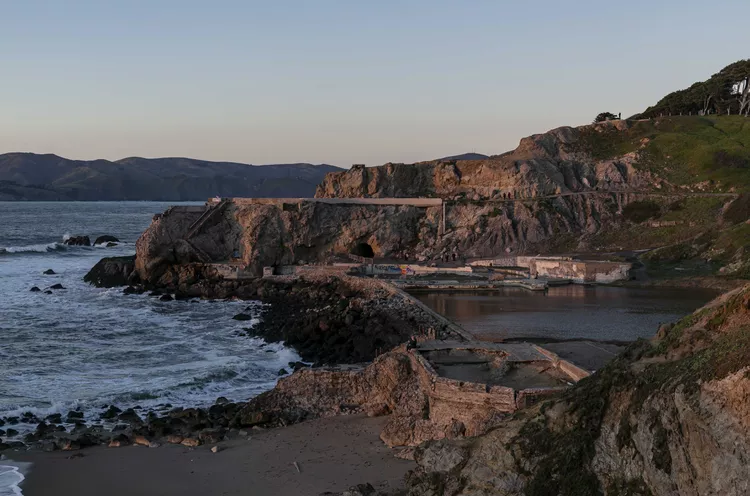1. Overview
Discover the history and legacy of the Sutro Baths in San Francisco, a once-grand public swimming complex. Explore what remains of this iconic site, its attractions, and how to visit.
2. History
A San Francisco landmark, the Sutro Baths were once the largest public indoor swimming pool complex in the world. Today, its ruins remain a testament to the city’s unique and fascinating history.
The baths were opened in 1896 by wealthy local businessman and the city’s 24th mayor, Adolph Sutro. They were larger than any facility the world had seen, drawing hundreds of thousands of visitors to San Francisco’s ‘Outerlands’ for decades. Sutro modeled the baths on European bathhouses where guests would relax and rejuvenate. Located below the popular Cliff House, this 100,000-square-foot complex began as an aquarium and featured six tide-fed, saltwater pools along with another freshwater pool of varying sizes and temperatures. The baths also provided exciting amenities such as trapezes and slides. Bathers could also explore an onsite natural history museum filled with taxidermy, European artworks, and exotic plants collected by Sutro during his travels.
The baths included a 2,700-seat amphitheater, observation bleachers, and hundreds of dressing rooms, along with rental options for bathing suits and towels. In many ways, the Sutro Baths were a comprehensive, all-day attraction.
Despite their initial success, the costs of operating the baths eventually took a toll. The Great Depression led to a significant drop in attendance. To counter this, Sutro’s family, who managed the baths after his death in 1898, added an ice skating rink in hopes of boosting profits—an effort that ultimately fell short. The Sutro family closed the baths in the 1950s, though they continued to operate the ice skating rink into the early ’60s before selling the property to developers. While they were in the process of demolishing the remaining structures to build high-rise apartments, a suspicious fire deemed arson struck in June 1966, leaving only ruins behind.
In 1976, the National Park Service acquired the Sutro Baths site, now part of the 82,027-acre Golden Gate National Recreation Area (GGNRA). Together, the various historically and ecologically significant landscapes that comprise GGNRA create one of the world’s largest urban parks. Notable GGNRA attractions include the Cliff House, Marin County’s Muir Woods, San Francisco’s Presidio, and Fort Mason.
3. What to See & Do
Although the Sutro Baths have been closed for decades, their grandeur and mystique continue to live on in San Francisco lore and films like the 1971 black comedy “Harold and Maude.” Visitors can still stroll along the sea wall and among the concrete remains, though they should exercise caution due to slippery surfaces and the potential for rogue waves.
Just south of the ruins sits San Francisco’s iconic Cliff House, currently the fifth incarnation of the establishment, offering stunning panoramic views that have drawn guests since 1858. The neoclassical version opened in 2005, and features the casual Bistro, the upscale Sutro’s, and a Terrace Room that hosts a Sunday champagne brunch, complete with various culinary delights and live music. Visitors can also browse the onsite gift shop and watch surfers at Ocean Beach while learning about the Camera Obscura, a giant walk-in camera that has provided 360-degree live images of the coastline since 1946.
Up the hill along Point Lobos Avenue lies Sutro Heights Park, another asset of the GGNRA worth exploring. Once home to Adolph Sutro, the area features remnants of his turreted mansion and expansive gardens filled with Victorian flower beds. Although much of the original estate has been lost over time, visitors can still see two lion statues at the entrance gate, replicas of the ‘Landseer Lions’ from London’s Trafalgar Square.
The surrounding area, known as Land’s End, offers excellent trails for day hikes, forming part of the GGNRA. This wild, rocky part of the city features nearly two miles of the California Coastal Trail, winding through 1,200 miles of California coastline. Explore overlooks, historic war batteries, and even a walkable labyrinth amidst cypress and eucalyptus trees, all while enjoying breathtaking views. The Merrie Way parking lot is the trailhead, hosting the Lands End Lookout Visitor Center, where visitors can learn more about the baths and the surrounding GGNRA.
If you’re looking for a budget-friendly meal accompanied by spectacular views, Louis’ is a family-owned restaurant above the Sutro Baths that has been in business since 1937. As a concessionaire of the National Park Service, Louis’ serves up a variety of diner-style dishes, including omelettes, burgers, and sandwiches. Note that the restaurant only accepts cash.
4. Getting There
The most convenient way to reach the Sutro Baths without a car is by utilizing public transportation. The Muni 38 Geary bus line terminates at 48th Avenue, followed by a brief downhill walk. Comfortable footwear is recommended, as the land around the baths may be slippery and uneven, with dirt trails common in the area.





